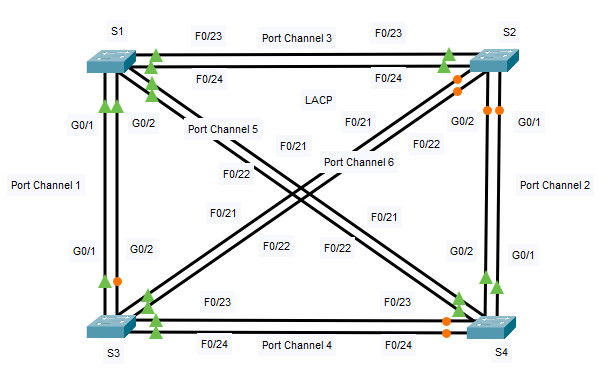6.3.4 Packet Tracer – Troubleshoot EtherChannel (Instructor Version)

Objectives
- Part 1: Examine the Physical Layer and Correct Switch Port Mode Issues
- Part 2: Identify and Correct Port Channel Assignment Issues
- Part 3: Identify and Correct Port Channel Protocol Issues
Background
A junior technician recently configured four switches. Users are complaining that the network is running slowly, and they would like you to investigate.
Port Channel Table
| Channel Group | Ports | Protocol |
|---|---|---|
| 1 | S1: G0/1, G0/2 S2: G0/1, G0/2 |
LACP active |
| 2 | S2: G0/1, G0/2 S4: G0/1, G0/2 |
LACP active |
| 3 | S1: F0/23, F0/24 S2: F0/23, F0/24 |
LACP active |
| 4 | S3: F0/23, F0/24 S4: F0/23, F0/24 |
LACP active |
| 5 | S1: F0/21, F0/22 S4: F0/21, F0/22 |
LACP active |
| 6 | S2: F0/21, F0/22 S3: F0/21, F0/22 |
LACP active |
Device Table
| Device | Group | Ports |
|---|---|---|
| S1 | 1 | G0/1, G0/2 |
| 3 | F0/23, F0/24 | |
| 5 | F0/21, F0/22 | |
| S2 | 2 | G0/1, G0/2 |
| 3 | F0/23, F0/24 | |
| 6 | F0/21, F0/22 | |
| S3 | 1 | G0/1, G0/2 |
| 4 | F0/23, F0/24 | |
| 6 | F0/21, F0/22 | |
| S4 | 2 | G0/1, G0/2 |
| 4 | F0/23, F0/24 | |
| 5 | F0/21, F0/22 |
Instructions
Part 1: Examine the Physical Layer and Correct Switch Port Mode Issues
Step 1: Look for access ports.
Examine the switches. When two or more redundant links connect the same switches, Spanning Tree protocol will only put one port in forwarding mode to prevent switching loops. You can see this in Packet Tracer. When physical ports are assigned to an EtherChannel port, they behave as one logical port. Each pair will either be operational or down.
Step 2: Verify ports are in trunk mode.
S2#show running-config . . ! interface FastEthernet0/21 switchport mode access channel-group 6 mode active ! interface FastEthernet0/22 switchport mode access channel-group 6 mode active ! interface FastEthernet0/23 switchport mode access channel-group 3 mode active ! interface FastEthernet0/24 switchport mode access channel-group 3 mode active ! interface GigabitEthernet0/1 switchport mode access channel-group 2 mode active ! interface GigabitEthernet0/2 switchport mode access channel-group 2 mode active ! ! end
a. Verify that all physical ports in the topology are configured as trunks. Correct any ports that are in access mode.
S2(config)#interface range f0/21-24, g0/1-2
S2(config-if-range)#switchport mode trunk
b. Correct any EtherChannel ports that are not configured as trunks.
S1(config)#interface port-channel 1 S1(config-if)#switchport mode trunk
S2(config)#interface port-channel 2 S2(config-if)#switchport mode trunk S2(config-if)#interface port-channel 3 S2(config-if)#switchport mode trunk S2(config-if)#interface port-channel 6 S2(config-if)#switchport mode trunk
Part 2: Identify and Correct Port Channel Assignment Issues
Step 1: Examine port channel assignments.
The Packet Tracer topology and the Port Channel and Device tables provide details about the physical ports and their EtherChannel assignments. Use the show etherchannel summary command to learn how the EtherChannel links are configured. Verify that the switches are configured as shown in the documentation.
Step 2: Correct port channel assignments.
Correct any switch ports that are not assigned to the correct EtherChannel port.
S4(config)#interface range f0/21-22 S4(config-if-range)#channel-group 5 mode active
Part 3: Identify and Correct Port Channel Protocol Issues
Step 1: Identify protocol issues.
In 2000, the IEEE released 802.3ad (LACP), which is an open standard version of EtherChannel. For compatibility reasons, the network design team chose to use LACP across the network. The design team has made it a requirement that all ports that participate in EtherChannel need to actively negotiate the link as LACP. Verify that the physical ports are configured as indicated in the topology and Port Channel Table.
S3#show etherchannel summary
Flags: D - down P - in port-channel
I - stand-alone s - suspended
H - Hot-standby (LACP only)
R - Layer3 S - Layer2
U - in use f - failed to allocate aggregator
u - unsuitable for bundling
w - waiting to be aggregated
d - default port
Number of channel-groups in use: 3
Number of aggregators: 3
Group Port-channel Protocol Ports
------+-------------+-----------+----------------------------------------------
1 Po1(SD) PAgP Gig0/1(I) Gig0/2(I)
4 Po4(SD) PAgP Fa0/23(I) Fa0/24(I)
6 Po6(SD) PAgP Fa0/21(I) Fa0/22(I)
Step 2: Correct Protocol issues.
a. Correct any switch ports that are not negotiating using LACP.
S3(config)# interface range g0/1-2 S3(config-if-range)# no channel-group S3(config-if-range)# channel-group 1 mode active S3(config-if-range)# interface range f0/21-22 S3(config-if-range)# no channel-group S3(config-if-range)# channel-group 6 mode active S3(config-if-range)# interface range f0/23-24 S3(config-if-range)# no channel-group S3(config-if-range)# channel-group 4 mode active
b. Reissue the show etherchannel summary command to verify that all EtherChannel links are now correctly configured.
S3#show etherchannel summary
Flags: D - down P - in port-channel
I - stand-alone s - suspended
H - Hot-standby (LACP only)
R - Layer3 S - Layer2
U - in use f - failed to allocate aggregator
u - unsuitable for bundling
w - waiting to be aggregated
d - default port
Number of channel-groups in use: 3
Number of aggregators: 3
Group Port-channel Protocol Ports
------+-------------+-----------+----------------------------------------------
1 Po1(SU) PAgP Gig0/1(P) Gig0/2(P)
4 Po4(SU) PAgP Fa0/23(P) Fa0/24(P)
6 Po6(SU) PAgP Fa0/21(P) Fa0/22(P)

Is there a bug with PT (latest version) if you switch from PAgP to LACP ?
It keeps showing PAgP in the “show etherchannel summary”. After a reload of the switch it seems to be fixed. Part 3 Step 2 of your answer also seems to be showing PAgP instead of LACP. I got stuck for almost half an hour not understanding why it wouldn’t switch to LACP